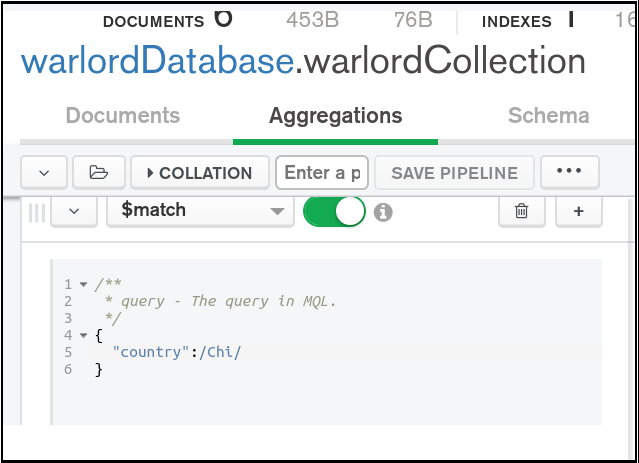

- #Mongodb compass filter multiple fields for free
- #Mongodb compass filter multiple fields how to
- #Mongodb compass filter multiple fields movie
- #Mongodb compass filter multiple fields install
- #Mongodb compass filter multiple fields password
Using queries like that is great to see the preliminary results of the collection you are trying to build. From within the Collections tab, you can see the data and make simple queries if you want.įor example, the query above shows every document with a date value later than August 18th, 2002. My project is called “Project 0” and has the “Example” database comprising three databases and 15 collections.Įach project has a set of tabs, one of which is the “Collections” tab, where you can see the databases and the documents in each collection, as shown in the image above. Start by going into the project’s database.
#Mongodb compass filter multiple fields movie
Your objective is to create a collection containing all the comments each movie received in August 2002. You’ll use the collection sample_mflix that contains movies, comments, users, etc. Whereas the records in a spreadsheet are lines, in MongoDB, a record is called a document. In Mongo, a dataset is called a collection think of it as a special spreadsheet.

#Mongodb compass filter multiple fields how to
You’ll be using the sample data from MongoDB to learn how to do an aggregation and create a new collection.
#Mongodb compass filter multiple fields for free
Remember that if you don’t have one yet, you can create one for free here, and MongoDB has a free tier you can set up while creating your account. This blog post assumes you already have an account set up with MongoDB.
#Mongodb compass filter multiple fields password
When prompted, enter the password you set when you created your administrative user.If you use MongoDB, you probably understand all there’s to know about it, so I recommend you skip this blog post here, but if you are starting with MongoDB, see this blog post as a gentle introduction 😉.
mongo -u AdminSammy -p -authenticationDatabase admin. Be sure to change these details in the following command to reflect your own setup, if different: This tutorial follows the conventions of the prerequisite MongoDB security tutorial and assumes the name of this administrative user is AdminSammy and its authentication database is admin. To create this sample collection, connect to the MongoDB shell as your administrative user. To explain how to create queries in MongoDB - including how to filter documents with multiple fields, nested documents, and arrays - this guide uses an example database containing a collection of documents that describe the five highest mountains in the world. It will generally work with any MongoDB installation regardless of the operating system as long as authentication has been enabled. This tutorial concentrates on MongoDB itself, not the underlying operating system. Note: The linked tutorials on how to configure your server, install, and then secure MongoDB installation refer to Ubuntu 20.04. To learn how to use MongoDB shell to perform CRUD operations, follow the tutorial How To Perform CRUD operations in MongoDB. Familiarity with MongoDB CRUD operations and retrieving objects from collections in particular. To secure MongoDB like this, follow our tutorial on How To Secure MongoDB on Ubuntu 20.04. Your server’s MongoDB instance secured by enabling authentication and creating an administrative user. #Mongodb compass filter multiple fields install
To set this up, follow our tutorial on How to Install MongoDB on Ubuntu 20.04. This tutorial was validated using a server running Ubuntu 20.04, and you can prepare your server by following this initial server setup tutorial for Ubuntu 20.04.
A server with a regular, non-root user with sudo privileges and a firewall configured with UFW. You will also learn what cursors are and how to use them within the MongoDB shell. In this tutorial, you’ll learn how to query MongoDB collections using a different range of filters and conditions. MongoDB provides a robust query mechanism for defining filtering criteria when retrieving documents. Similar to how you would find your holiday destination by selecting a range of filters on a booking website, such as distance from the seaside, pet-friendliness, a pool, and nearby parking, you can precisely query MongoDB to find exactly the documents you need. Instead, you’ll more likely want to only retrieve documents that satisfy one or more particular conditions. Regardless of how complex your documents are or how many you have, most often you won’t need to review the data in all of them at once. Others might be highly complex, containing dozens of fields of different types, arrays holding multiple values, and even other documents nested within the larger structure. Some might be relatively small and contain only a few entries, like items in a shopping list. Introductionĭocuments stored in a MongoDB database can vary widely. The author selected the Open Internet/Free Speech Fund to receive a donation as part of the Write for DOnations program.






 0 kommentar(er)
0 kommentar(er)
